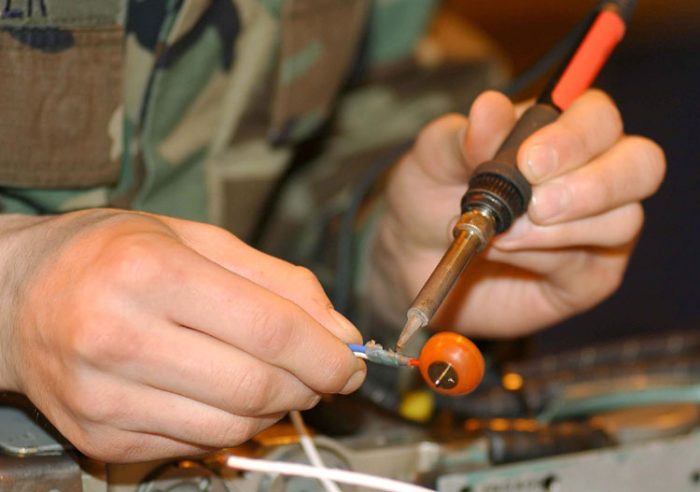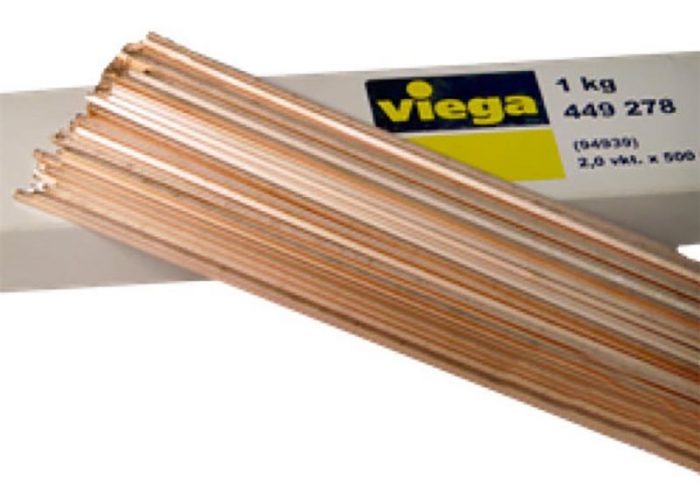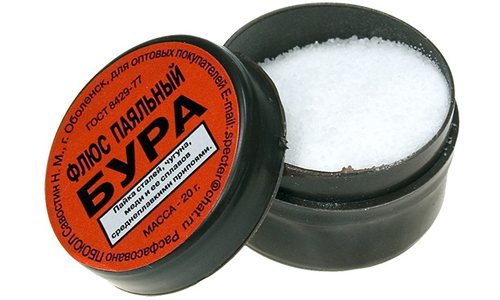Alloy of copper with zinc, known since ancient times, is widely used in our time. Brass has high strength, corrosion resistant, ductile. Thanks to such properties, it is used to make parts of mechanisms, structural elements that are forced to constantly contact aggressive environments. Despite the reliability of the material, various defects sometimes need to be repaired in brass products — fractures, holes, cracks. One way to recover elements is soldering. This process is not very complex, but it has its own characteristics, so it is extremely important to know how to solder brass. Familiarity with the soldering technology will allow you to successfully carry out such work even at home.
What are the features of the technology?

This method of producing permanent joints is not as popular as welding. The reason is a lower solder strength. Seams form due to the melting of filler material called solder. The most important difference between soldering is the melting temperature, which should be lower than that of the connected elements. They do not change the state of aggregation, which makes it possible to reliably bond dissimilar materials.
The low-temperature effect on the soldered surface made soldering indispensable, and in some cases the only possible one: for example, when it is necessary to obtain an integral connection of dissimilar metals. The integrity of the workpieces is the main advantage of such a technological operation, since it allows you to work with the smallest elements, without fear for their deformation or structural change.
Soldering is especially relevant in electronics, where you have to work with tiny, very fragile microcircuits, and electrics, when it becomes necessary to connect or build up conductors.
Classification of Brass Alloys

Brass is either double or multicomponent. In the first case, the composition includes only copper and zinc, which increases the hardness of the alloy. Other components that improve its physical and chemical characteristics are aluminum, iron, silicon, manganese, nickel, tin, lead, and other elements. For this reason, it is necessary to know exactly the composition of brass in advance, this will help determine the method, as well as the specifics of soldering.
Brass is classified by chemical composition:
- Two-component (double, simple). It consists only of copper and zinc. The percentage of these components may be different. These compounds are marked with the letter «L» and a number that always indicates the amount of copper. For example, L90 contains from 88 to 91% copper, zinc accounts for 8.8-12%. There are impurities, but their amount is minimal — about 0.2%.
- Multicomponent (special). This brass has a large number of ingredients that increase the corrosion resistance of the alloy, its strength, hardness. It is labeled in a different way: one more letter, which means an alloying element, is added to the letter “L”; another figure appears — the percentage of alloying metal. For example, LA77-2 is aluminum brass, it contains 77% copper, about 2% aluminum, and the rest is zinc. All such alloys are called in honor of the alloying element: ferrous, siliceous, nickel, manganese, lead, etc.

Brass goes to the manufacture of various products. According to the degree of processing, these alloys are divided into:
- deformable, they produce bolts, nuts, car parts, brass tapes, sheets, wire, pipes, pipes;
- foundries (fittings, bushings, instrument parts, bearings, automobile hydraulic fittings).
According to the percentage of zinc, brass is divided into:
- Red (tompak), having 5-10% of this component. Such alloys are ideal for jewelry, figurines, and similar artwork.
- Yellow, here the percentage of zinc is 21-36%.
The reason for the popularity of brass is its durability, reliability, resistance to temperature extremes, and mechanical stresses. Therefore, parts made of this alloy are widely used in water supply systems, sewage facilities, in machine and instrument engineering. Brass products have a long service life, but this is only true if their operating rules are not violated.
Efficiency and obstacles
There are several technologies that allow you to easily weld parts or products from brass, but they are not simple, they promise tangible costs, they require certain skills from the master. Soldering is an alternative that is technologically simpler, which means that this option is also suitable for a home master, since there is no need for a highly skilled performer.

If the zinc content in the alloy is not too high, then there are no insurmountable obstacles to the goal: simple soldering using ordinary rosin allows you to cope with the task. When the percentage of this metal in brass exceeds 15, special fluxes are needed.
The reason is the strong evaporation during the soldering of copper and zinc, it leads to the formation of a strong oxide film on the material, and it is quite difficult to remove it. Therefore, without special solders and neutralizing fluxes, an ideal result cannot be achieved.
The choice of optimal materials
Before you look for the best option for brazing brass, you must establish its brand. Only in this case can an acceptable result of the operation be guaranteed.
Choosing the right solder

Это материал, обычно сплав, которым спаивают элементы. Главная его особенность — температура плавления, обязанная быть ниже, чем у соединяемых металлов. Типичные примеры сплава — олово со свинцом, чистое олово. Однако качество, механическая прочность такого сцепления и внешний вид очень далеки от идеала. Причины низкого качества — поры, появляющиеся в результате испарения цинка. Чтобы обеспечить надежный контакт, температура плавления материала обязана быть значительно ниже латунной, а припой должен обладать отличной адгезией с этим сплавом.
- It is a material, usually an alloy, used to solder elements. Its main feature is the melting temperature, which must be lower than that of the metals being joined. Typical examples of the alloy are tin with lead, pure tin. However, the quality, mechanical strength of such adhesion and appearance are very far from ideal. The reasons for poor quality are the pores resulting from the evaporation of zinc. To ensure reliable contact, the melting temperature of the material must be significantly lower than brass, and the solder must have excellent adhesion to this alloy.
- For brazing brass containing a large amount of copper, it is better to take compounds related to copper-zinc solders, since as a result of zinc addition the melting point of these alloys decreases. For example, PMC54 and PMC-48 solders melt at a temperature of 880 °, PMC-36 — at 800-825 °.
- For the same alloys, you can use silver solders — grades from PSr12 to PSr72. If brass has a higher zinc content, then similar solders are recommended, but not lower than PSr40.
- Copper-phosphorus solders are relatively inexpensive — MF-1, MF-2, MF-3. They are plastic, but have good electrical conductivity. If mechanical and vibration loads are high, it is better to purchase solders with silver.
If you want to guarantee special strength, then choose solid copper alloys: for example, universal L-CuP6.

The last brand of solder has a temperature range of 710-880. It is designed to work with bronze, red bronze, brass, as well as copper, when installing pipes, radiators, heating systems. When using silver or phosphorus solders, it must be borne in mind that brass dissolves intensively, so the processing time (heating and soldering) must be reduced.
Fluxes: home-made or ready-made
Fluxes clean the surface of metals from fat, and also prevent the formation of an oxide film. They are also selected depending on the composition of the alloys. Rosin alone is sufficient for copper compounds, but a more aggressive agent is already needed for brass. The simplest version of the brass brazing flux is a mixture of borax with boric acid (1: 1). It is poured with water (5 mm per 1 g), boiled, stirring, then cooled. However, the best characteristics are possessed by «professionals» — purchased compositions.

- Borax flux. He is known for a very long time, but since then he has not lost his fans. The reason for popularity is its quality work.
- Other brands are no less effective: PV-209 (from 700 to 900 °), PV-209X (from 650 to 850 °).
Popular import brands are German powders FELDER Cu-Rosil, Chemet FLISIL-NS-Pulver, flux paste Chemet FLISIL-NS-Paste. There are many fluxes on the market designed for brazing of brass — both imported and domestic, so there will be no problems with the choice.
Two brazing methods
As already noted, the biggest difficulty in working with brass is the formation of an oxide film when the alloy is heated, with which rosin (even in the company of alcohol) is unable to cope.
Using a soldering iron

To solder this alloy, you need a powerful device — at least 500 watts, maximum — 1000 watts. This requirement is associated with a high melting point — both alloy and solders. However, there are exceptions: these are brass alloys having a lower melting point (a large percentage of copper). The best option is a soldering station, which makes it possible to regulate the heating of the soldering iron tip. The optimal parameter is 350 °. This equipment will avoid overheating of the solder zone.
If the alloy is dominated by copper, then in this case, you can use a modest power tool — 100 watts. Orthophosphoric or soldering acid is used as a flux: the surfaces of brass products are carefully processed before soldering. POS-60 (tin-lead) is used as solder.
Torch Soldering

The same problem can be solved using a not too large burner. But in this case, there is the main requirement for the working surface: the brass part must be placed on a heat-resistant material. For example, on a small asbestos plate, in an iron bucket with small pebbles. The connected parts are combined with each other, the surfaces are wiped with a flux with a base-bora. Sprinkle a small amount of silver solder chips on top, then introduce the flame of a gas burner into the soldering zone.
Warming up is carried out in stages. First, the area is heated slightly: so that the solder can grasp the surfaces of the alloys. The second stage is the heating of the zone until the appearance of redness, during which the solder evenly spreads over the surface, filling the gaps. At this point, a temperature of 700-750 ° is reached.

The burner is turned off. After the soldering zone has cooled, it is washed, removing flux residues — sagging, glassy drops: first, the product is immersed for several minutes in a hot solution of sulfuric acid (3%), then placed under running water.
These methods differ from the traditional connection of other elements using tin, as brazing is not so simple. The best result is guaranteed by the use of a gas burner. If you perform all stages of the operation correctly, you can get high-quality and reliable products.